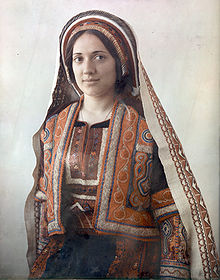
Embroidery was an important art in the Islamic world from the beginning of Islam until the Industrial Revolution disrupted traditional ways of life.

Embroidery was an important art in the Islamic world from the beginning of Islam until the Industrial Revolution disrupted traditional ways of life.

Early Islam took over societies where the embroidery of clothes for both sexes and other textiles was very popular. Both the Byzantine and Persian Sasanian empires used clothing embroidered with designs including rather large human figures as well as animals, with effects comparable to those of modern teeshirts. The exterior of the Kaaba in Mecca was already before Islam "covered on the outside with multi-coloured textile hangings", [1] very likely including embroidery as their modern Islamic equivalents often have. Muhammad objected to animal designs, perhaps embroidered, he saw on cushions when visiting his wife Aisha's house. [lower-alpha 1] These types of design largely disappeared under Islam, though plant-based motifs often remained acceptable.
The 17th century Turkish traveller Evliya Çelebi called embroidery the "craft of the two hands". [3] Because it was a sign of high social status in Muslim societies, it had long been widely popular. In cities such as Damascus, Cairo and Istanbul, embroidery was visible on handkerchiefs, uniforms, flags, calligraphy, shoes, robes, tunics, horse trappings, slippers, sheaths, pouches, covers, and even on leather belts. Craftsmen embroidered items with gold and silver thread. Embroidery cottage industries, some employing over 800 people, grew to supply these items. [3]
In the 16th century, in the reign of the Mughal Emperor Akbar, his chronicler Abu al-Fazl ibn Mubarak wrote in the famous Ain-i-Akbari :

His majesty [Akbar] pays much attention to various stuffs; hence Irani, Ottoman, and Mongolian articles of wear are in much abundance especially textiles embroidered in the patterns of Nakshi, Saadi, Chikhan, Ari, Zardozi, Wastli, Gota and Kohra. The imperial workshops in the towns of Lahore, Agra, Fatehpur and Ahmedabad turn out many masterpieces of workmanship in fabrics, and the figures and patterns, knots and variety of fashions which now prevail astonish even the most experienced travellers. Taste for fine material has since become general, and the drapery of embroidered fabrics used at feasts surpasses every description. [4]
Embroidery offered symbolic protection for the most highly valued objects, including babies, household possessions and things with religious significance. When in the 16th and 17th centuries in Turkey, men wore turbans as a sign of Islam, they placed their turbans under embroidered cloths. [5]

A wide variety of embroidery techniques were used across the Islamic world, with an equally broad range of materials. [6]
Uighur women embroider felt skull caps, for use on their own or as the base for a turban. [7]
In Morocco and Tunisia, satin stitch was used for items such as decorative curtains and mirror covers. [8] A form of satin stitch present in the Bedouin societies of the Arabian Peninsula, sometimes referred to as khiyat al madrassa ("school embroidery"), was used for furnishings. Prior to the stitching process, a shape was drawn onto the fabric by a skilled artist. Designs incorporating natural themes such as birds or flowers were most common. [9]
Surface satin stitch, worked only on the upper surface, is a more economical but looser technique, vulnerable to wear, and so is mainly used for special occasions. In Punjab, Phulkari (flower work) shawls were however daily wear for women in the countryside, while special ones, bagh, were completely covered with embroidery and were made by maternal grandmothers for their granddaughters' weddings. [10]
Chain stitch, which is adaptable and relatively easy to create, was used in Persia for Resht embroidery, with densely worked flowers and arabesques on felted woollen cloths. [11] A type of embroidery similar to heavy chain stitch, known as kurar , was previously used by Bedouin to create dresses for both men and women. It required four people, with each person carrying four threads which were either of varying colors or silver and gold. [12]

Cross stitch was used across the Middle East in Syria, Jordan, Palestine and Sinai to work wedding dresses with bold embroidery in red, with triangular amulets or carnation flowers on a black background. [13]
Another widely used technique, Herringbone stitch, was used in Afghanistan to embroider bridegroom's smocks with raised bands of red, green or white stitchery on a white background. [14]
Couching, the stitching of decorative cord on to the surface of a fabric, was used widely across the Islamic world. In Afghanistan, a velvet dress could be worked in military style with gold-coloured threads on the front, sleeves and hem. Chieftains in Montenegro could wear robes heavily couched in gold thread. In Palestine, dresses could be heavily worked in vertical panels with couched threads of metal and cotton. In Syria, jackets were couched with stylised flowers and trees. In the Northwest Frontier of Pakistan, waistcoats were sewn with a combination of appliqué panels and couched metal braid. [15]

In Central Asia, Bokhara couching using continuous thread creates spectacular suzanis, hangings for wedding halls and bridal beds. Carnation and pomegranate motifs symbolised fertility. The technique was also used in Afghanistan and Uzbekistan for horse blankets and brazier covers. [16]
Blanket stitch, buttonhole stitch, and eyelet stitch all had the original function of strengthening the edges of textiles subject to daily wear and tear, but were adapted for decorative purposes. In North Africa and the Middle East, eyelet stitch is made using a spoked wheel pattern of stitches, or in the Algerian form without an enclosing circle. In Turkmenistan, hook and tulip motifs could be worked in buttonhole stitch. In Afghanistan, men's shirts could be embroidered with herringbone and buttonhole stitches in white silk on white cotton, in elaborate arabesques. [17]
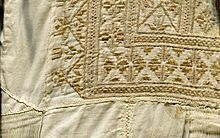
Whitework, the use of white thread on a white ground, covers a variety of techniques and materials, and is used in different forms around the world. In Algeria, Kabyle women could wear whitework dresses. In Ghazni, Afghanistan, men's smocks could be embroidered with geometric whitework stitching embellished with small circular mirrors. [18]
Needlepoint (canvaswork) was used for brightly coloured geometrical Hazara dress panels in Afghanistan. [19]
Smocking was used for men's smocks in Nuristan in the Hindu Kush, the black stitching pulling the cloth into vertical bands with zigzag, crisscross and other simple geometric patterns. [20]
Tambour work, a rapid form of embroidery using a fine ari hook instead of a needle, was one of the techniques used around Bokhara in Uzbekistan for suzanis. [21]
Embroidered motifs often carry symbolic meaning. A widespread symbol across the Islamic world (and also often found on Islamic carpets) is the tree of life, signifying birth, growth to maturity, death and rebirth. It can be shown in many forms, such as a deliberately stylised tree, sometimes flanked by pairs of birds or fruits such as pomegranates, or a vase of flowers. [22]

Embroidered textiles are features of the holy sanctuaries of Islam: the Great Mosque in Mecca and the Prophet's Mosque in Medina. They are regularly replaced, in traditions that go back centuries. Replacing the textiles is one of the privileges of the Custodian of the Two Holy Mosques, a title adopted by Mamluk, Ottoman, and Saudi Arabian rulers. [23] The covering of the Kaaba, known as the kiswah , includes a sitara (a richly decorated curtain over the door) and hizam (a belt that wraps around the building). The earliest known sitara was made in 1544 in Egypt and the earliest Ottoman hizam was made for Selim II in the late 16th century. The basic designs of the sitara and hizam have changed little, although the embroidery in gold and silver wire have become more ornate over time. [24] The Maqam Ibrahim (Station of Abraham) is a small square stone near the Kaaba which, according to Islamic tradition, bears the footprint of Abraham. [25] It used to be housed in a structure with its own sitara that was replaced annually. [26]
Averaging 5.75 metres (18.9 ft) by 3.5 metres (11 ft), the sitara for the door of the Kaaba is assembled by sewing together four separate textile panels; the hizam is similarly assembled from eight panels (two for each wall of the Kaaba). [26] A dedicated workshop, the Dar al-Kiswa, was created in Cairo in 1817, which at its peak employed 100 craftsmen to make the kiswa and other textiles for Mecca and Medina. Since 1962 they have been produced at a workshop in Mecca. [26] [24] The colours used have changed in different eras. The present colour scheme for the sitara of the Kaaba, in use since the early 20th century, is gold and white embroidery on a black background. [27] A modern kiswah uses 670 kilograms (1,480 lb) of silk and is embroidered with 15 kilograms (33 lb) of gold thread. [28] These inscriptions include verses from the Quran and supplications to Allah, as well as the names of the rulers who commissioned the textiles. [27] [26] The shahada (the Islamic declaration of faith) is another text used commonly. [29]
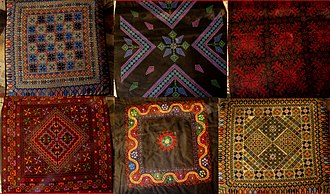
Embroidery was important in traditional cultures across the Islamic world. The Industrial Revolution made colourful clothing available more quickly and more cheaply, displacing crafts such as embroidery. [30]
For example, the masnat (enthronement) cloths of Hyderabad, India were made of velvet, hand-embroidered with glittering copper thread forming gold- and silver-coloured flowers (formerly actually of those metals). These were made for Mughal emperors and other rulers, and also for the bride and groom to sit on during weddings in Hyderabad. The technique derived from Turkey and Persia. A masnat takes between twelve days and two months to make, and can cost up to 100,000 rupees. Business declined during the 20th century, as fewer traditional cloths were ordered. Wedding providers offered a masnat as part of their service; machine-made cloths edged out handmade ones. As of 2012, only a few elderly masnat makers remained. [31]
The embroidery researcher Sheila Paine concludes her book Embroidered Textiles by explaining that [30]
once the social context no longer exists and the beliefs and fears that embroidery promoted or deflected no longer torment, once linen is no longer painfully cultivated, spun and woven, sheep are no longer the mainstay of life and exotic silks from other lands a precious luxury – then traditional embroidery is doomed. [30]
Among the causes of embroidery's decline are politics and economics, but Paine suggests that the most powerful factor has been the education of young women. Embroidery is no longer the only way the young woman in Turkey or Baluchistan can secure her future by winning a husband; instead, she can aspire to a university degree and a career of her own. Paine argues that attempts to reinstate traditional embroidery, as with schools set up in Istanbul and Salamanca, will inevitably fail once the necessary social environment that gave handmade artefacts meaning has collapsed. In future, she states, embroidery will carry individual meaning, as in the West, and perhaps new social purposes, as with the politically significant embroidered dresses of the Palestinians. [30] [32]

Embroidery is the art of decorating fabric or other materials using a needle to apply thread or yarn. Embroidery may also incorporate other materials such as pearls, beads, quills, and sequins. In modern days, embroidery is usually seen on caps, hats, coats, overlays, blankets, dress shirts, denim, dresses, stockings, scarfs, and golf shirts. Embroidery is available in a wide variety of thread or yarn colour. It is often used to personalize gifts or clothing items.

Chain stitch is a sewing and embroidery technique in which a series of looped stitches form a chain-like pattern. Chain stitch is an ancient craft – examples of surviving Chinese chain stitch embroidery worked in silk thread have been dated to the Warring States period. Handmade chain stitch embroidery does not require that the needle pass through more than one layer of fabric. For this reason the stitch is an effective surface embellishment near seams on finished fabric. Because chain stitches can form flowing, curved lines, they are used in many surface embroidery styles that mimic "drawing" in thread.
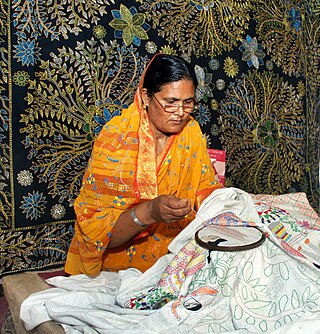
Kantha, also spelled kanta or qanta, is a type of embroidery craft in Bangladesh and eastern regions of India, particularly in the Indian states of West Bengal, Tripura and Odisha. In Odisha, old saris are stacked on each other and hand-stitched to make a thin piece of cushion. This is normally used above a bed cushion or instead of a cushion. "Kantha saris" are traditionally worn by women in Bengal region. In these days, embroidery is stitched, popularly known as 'kantha stitched", on sari, kurta and churidar and many other garments and gaining popularity due to their aesthetic value and handmade characteristics.

Korean embroidery techniques and artifacts have a long history, but there is the most evidence from the Joseon Dynasty, after the 14th century in Korea. This article talks about the history, styles, preservation, artists, and examples of screens, costumes, and domestic wares of this exacting and beautiful art form.

Kiswa is the cloth that covers the Kaaba in Mecca, Saudi Arabia. It is draped annually on the 9th day of the month of Dhu al-Hijjah, the day pilgrims leave for the plains of Mount Arafat during the Hajj. A procession traditionally accompanies the kiswa to Mecca, a tradition dating back to the 12th century. The term kiswa has multiple translations, with common ones being 'robe' or 'garment'. Due to the iconic designs and the quality of materials used in creating the kiswa, it is considered one of the most sacred objects in Islamic art, ritual, and worship.

Chikankari is a traditional embroidery style from Lucknow, India. Translated, the word means embroidery, and it is one of Lucknow's best known textile decoration styles. The main market in Lucknow for Chikankari based products is Chowk. Production is mainly based in Lucknow and in the adjoining districts.

Whitework embroidery is any embroidery technique in which the stitching is the same color as the foundation fabric. Styles of whitework embroidery include most drawn thread work, broderie anglaise, Hardanger embroidery, Hedebo embroidery, Mountmellick embroidery, reticella and Schwalm. Whitework embroidery is one of the techniques employed in heirloom sewing for blouses, christening gowns, baby bonnets, and other small articles.
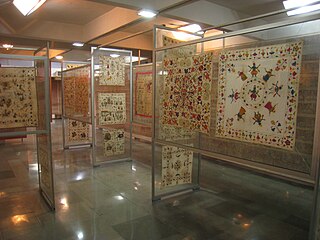
Embroidery in India includes dozens of embroidery styles that vary by region and clothing styles. Designs in Indian embroidery are formed on the basis of the texture and the design of the fabric and the stitch. The dot and the alternate dot, the circle, the square, the triangle, and permutations and combinations of these constitute the design.
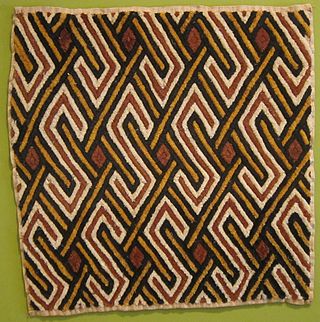
African textiles are textiles from various locations across the African continent. Across Africa, there are many distinctive styles, techniques, dyeing methods, and decorative and functional purposes. These textiles hold cultural significance and also have significance as historical documents of African design.

In embroidery, couching and laid work are techniques in which yarn or other materials are laid across the surface of the ground fabric and fastened in place with small stitches of the same or a different yarn.

Cross stitches in embroidery, needlepoint, and other forms of needlework include a number of related stitches in which the thread is sewn in an x or + shape. Cross stitch has been called "probably the most widely used stitch of all" and is part of the needlework traditions of the Balkans, Middle East, Afghanistan, Colonial America and Victorian England.

Goldwork is the art of embroidery using metal threads. It is particularly prized for the way light plays on it. The term "goldwork" is used even when the threads are imitation gold, silver, or copper. The metal wires used to make the threads have never been entirely gold; they have always been gold-coated silver or cheaper metals, and even then the "gold" often contains a very low percent of real gold. Most metal threads are available in silver and sometimes copper as well as gold; some are available in colors as well.
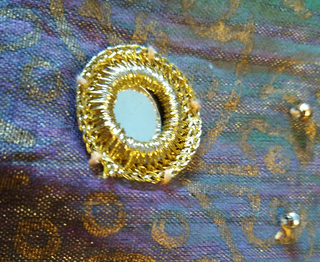
Shisheh or abhla bharat embroidery, or mirror-work, is a type of embroidery which attaches small pieces of mirrors or reflective metal to fabric. Mirror embroidery is common throughout Asia, and today can be found in the traditional embroidery of the Indian subcontinent, Afghanistan, China, and Indonesia.

Palestinian traditional clothing are the types of clothing historically and sometimes still presently worn by Palestinians. Foreign travelers to Palestine in the 19th and early 20th centuries often commented on the rich variety of the costumes worn, particularly by the fellaheen or village women. Many of the handcrafted garments were richly embroidered and the creation and maintenance of these items played a significant role in the lives of the region's women.

English embroidery includes embroidery worked in England or by English people abroad from Anglo-Saxon times to the present day. The oldest surviving English embroideries include items from the early 10th century preserved in Durham Cathedral and the 11th century Bayeux Tapestry, if it was worked in England. The professional workshops of Medieval England created rich embroidery in metal thread and silk for ecclesiastical and secular uses. This style was called Opus Anglicanum or "English work", and was famous throughout Europe.

The Kaaba, sometimes referred to as al-Ka'ba al-Musharrafa is a stone building at the center of Islam's most important mosque and holiest site, the Masjid al-Haram in Mecca, Saudi Arabia. It is considered by Muslims to be the Bayt Allah and is the qibla for Muslims around the world.

The term Hedebo embroidery covers several forms of white embroidery which originated in the Hedebo (heathland) region of Zealand, Denmark, in the 1760s. The varied techniques which evolved over the next hundred years in the farming community were subsequently developed by the middle classes until around 1820. They were applied to articles of clothing such as collars and cuffs but were also used to decorate bed linen.

A sitara or sitarah is an ornamental curtain used in the sacred sites of Islam. A sitara forms part of the kiswah, the cloth covering of the Kaaba in Mecca. Another sitara adorns the Prophet's Tomb in the Al-Masjid an-Nabawi mosque in Medina. These textiles bear embroidered inscriptions of verses from the Quran and other significant texts. Sitaras have been created annually since the 16th century as part of a set of textiles sent to Mecca. The tradition is that the textiles are provided by the ruler responsible for the holy sites. In different eras, this has meant the Mamluk Sultans, the Sultans of the Ottoman Empire, and presently the rulers of Saudi Arabia. The construction of the sitaras is both an act of religious devotion and a demonstration of the wealth of the rulers who commission them.
The Dar al-Kiswa al-Sharifa, abbreviated Dar al-Kiswa, was an artistic workshop in Cairo, Egypt, which operated from 1817 to 1997. For more than a century, it made sacred textiles for the Islamic holy sites in Mecca and Medina including the kiswah, the ornamental textile covering of the Kaaba which is replaced annually. The kiswah and other sacred textiles were conveyed each year across the hundreds of miles of desert from Cairo to Mecca on camels among the Hajj pilgrims. The workshop also made textiles for royal and state purposes, including military and police uniforms. At its peak at the start of the 20th century, the workshop employed over a hundred craftsmen to make textiles for the holy sites. Egypt sent the kiswah every year with few exceptions until 1962, when the kiswah sent to Mecca was returned unused. From then on, the textiles were made in a dedicated factory in Mecca. The building is now a government storage space.
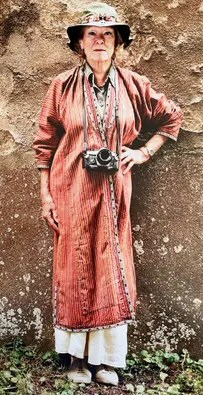
Sheila Paine was an English expert on Islamic embroidery. She was known for her travel books including The Afghan Amulet, describing her efforts to find the "linen goddess", an embroidered motif found from Greece to central Asia, and the origins of an elaborately embroidered "Kohistan" dress she had seen in a dealer's shop in London. Her work was exhibited at the Pitt Rivers Museum, Oxford.